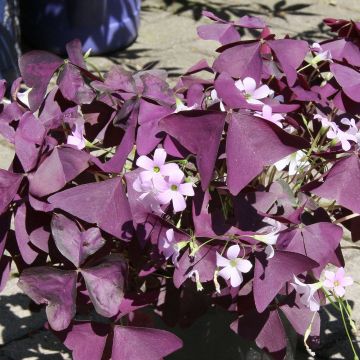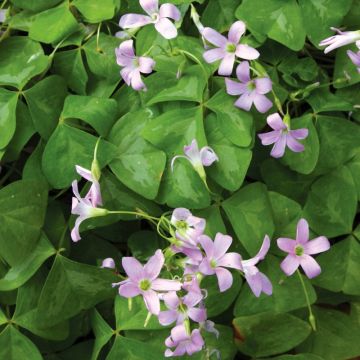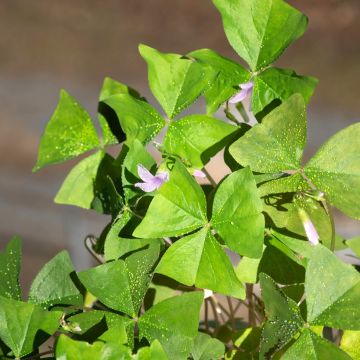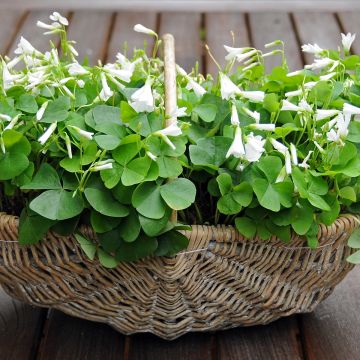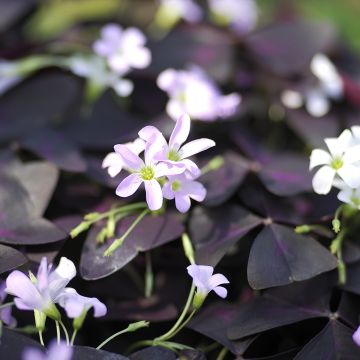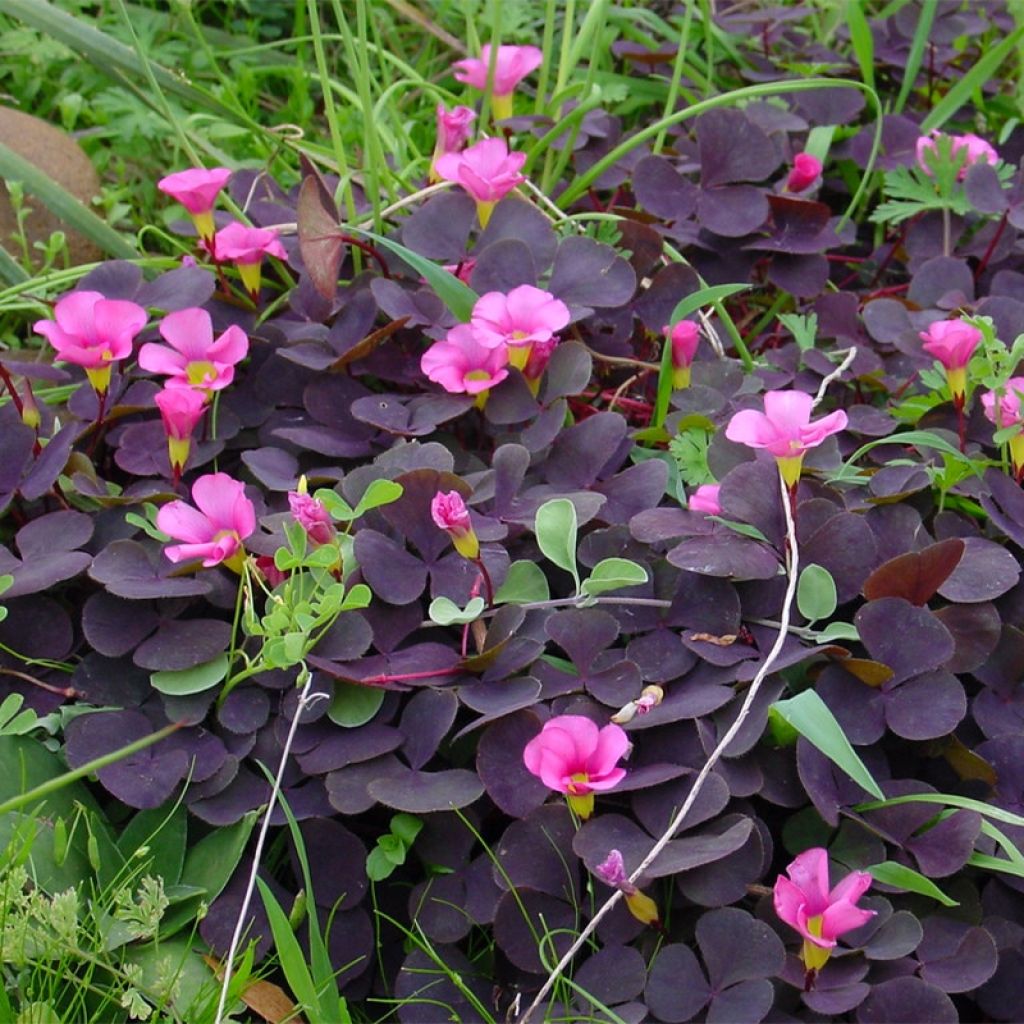

Oxalis purpurea Garnet
Oxalis purpurea 'Garnet'
Oxalis purpurea Garnet
Purple Woodsorrel, Purple Oxalis, Violet Wood-sorrel
Why not try an alternative variety in stock?
View all →This plant carries a 6 months recovery warranty
More information
We guarantee the quality of our plants for a full growing cycle, and will replace at our expense any plant that fails to recover under normal climatic and planting conditions.
From €5.90 for pickup delivery and €6.90 for home delivery
Express home delivery from €8.90.
Does this plant fit my garden?
Set up your Plantfit profile →
Description
Oxalis purpurea 'Garnet' is a very attractive representative of the purple Oxalis, which enhances the vivacity of its colours and is as generous as it is easy to live with. It is a non-invasive small bulbous plant that forms over time a carpet of deep chocolate purple clover leaves, animated by a multitude of bright pink flowers with golden hearts for several months. In Mediterranean climates, flowering occurs in autumn and winter, and the plant rests throughout the summer. Elsewhere, this flowering will be more likely in spring. A lovely rock garden plant that also adapts very well to pot cultivation.
Oxalis purpurea 'Garnet' belongs to the Oxalidaceae family and its ancestor is native to South Africa. It is an herbaceous plant that grows from a small "bulb", or more precisely a tuberized rhizome. The hardiness of this plant allows it to withstand a brief frost of -10°C (14°F) if the soil is very well drained, almost dry. The vegetation emerges from the ground in autumn and disappears before summer, which corresponds to its resting period. The plant measures about 10cm (4in) in height and spreads on the ground, sometimes covering an area larger than 60cm². Without stems, it develops leaves carried by a long petiole emerging directly from the rhizome. The leaf, carried by a red petiole, is divided into 3 generally triangular leaflets, of variable shape, and purple-brown in colour. The leaves orient themselves following the light: they close on the petiole in the evening and spread out at sunrise. The flowering is long, from October to March in Mediterranean climates. Elsewhere, the plant usually flowers from March to June-July, and sometimes again in September-October. The flowers are carried by a long petiole and have a funnel shape with 5 rounded lobes.
Mostly perennial plants with bulbous or rhizomatous roots, Oxalis are rarely used, yet they flower abundantly and have a wide range of uses. In short, they are plants for gardeners who want to venture off the beaten path. The Oxalis purpurea Garnet will make a big impact in a rock garden, but also in a hanging basket or flower pot. For example, you can associate it with small spring bulbs (tulips, daffodils, crocuses) or other ground-covering plants such as aubrietas, silver baskets, sedums...
Report an error about the product description
Oxalis purpurea 'Garnet' in pictures
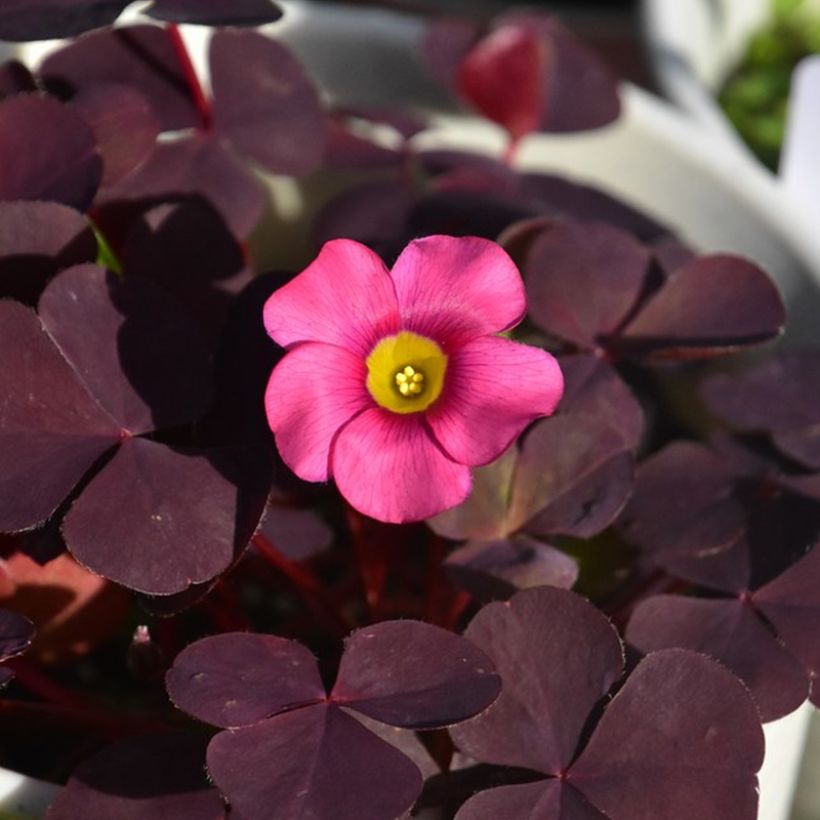

Plant habit
Flowering
Foliage
Botanical data
Oxalis
purpurea
Garnet
Oxalidaceae
Purple Woodsorrel, Purple Oxalis, Violet Wood-sorrel
South Africa
Other Oxalis
Planting and care
Oxalis purpurea 'Garnet' can be planted in open ground in our regions that are not too cold, or in a pot. Its preferred climate is Mediterranean, but it is an adaptable plant that will adjust its vegetative cycle to the climate. The bulbs can withstand a brief frost of around -10°C (14°F) if they are planted in soil that does not retain water. Plant the bulbs in the sun, in light and well-drained soil, whether it is slightly acidic, neutral or slightly alkaline. A mixture of compost, garden soil and fine gravel will work very well. Preferably plant in a rockery, on a slope or in a raised bed, a bed on gravel...
Planting period
Intended location
Care
This item has not been reviewed yet - be the first to leave a review about it.
Haven't found what you were looking for?
Hardiness is the lowest winter temperature a plant can endure without suffering serious damage or even dying. However, hardiness is affected by location (a sheltered area, such as a patio), protection (winter cover) and soil type (hardiness is improved by well-drained soil).

Photo Sharing Terms & Conditions
In order to encourage gardeners to interact and share their experiences, Promesse de fleurs offers various media enabling content to be uploaded onto its Site - in particular via the ‘Photo sharing’ module.
The User agrees to refrain from:
- Posting any content that is illegal, prejudicial, insulting, racist, inciteful to hatred, revisionist, contrary to public decency, that infringes on privacy or on the privacy rights of third parties, in particular the publicity rights of persons and goods, intellectual property rights, or the right to privacy.
- Submitting content on behalf of a third party;
- Impersonate the identity of a third party and/or publish any personal information about a third party;
In general, the User undertakes to refrain from any unethical behaviour.
All Content (in particular text, comments, files, images, photos, videos, creative works, etc.), which may be subject to property or intellectual property rights, image or other private rights, shall remain the property of the User, subject to the limited rights granted by the terms of the licence granted by Promesse de fleurs as stated below. Users are at liberty to publish or not to publish such Content on the Site, notably via the ‘Photo Sharing’ facility, and accept that this Content shall be made public and freely accessible, notably on the Internet.
Users further acknowledge, undertake to have ,and guarantee that they hold all necessary rights and permissions to publish such material on the Site, in particular with regard to the legislation in force pertaining to any privacy, property, intellectual property, image, or contractual rights, or rights of any other nature. By publishing such Content on the Site, Users acknowledge accepting full liability as publishers of the Content within the meaning of the law, and grant Promesse de fleurs, free of charge, an inclusive, worldwide licence for the said Content for the entire duration of its publication, including all reproduction, representation, up/downloading, displaying, performing, transmission, and storage rights.
Users also grant permission for their name to be linked to the Content and accept that this link may not always be made available.
By engaging in posting material, Users consent to their Content becoming automatically accessible on the Internet, in particular on other sites and/or blogs and/or web pages of the Promesse de fleurs site, including in particular social pages and the Promesse de fleurs catalogue.
Users may secure the removal of entrusted content free of charge by issuing a simple request via our contact form.
The flowering period indicated on our website applies to countries and regions located in USDA zone 8 (France, the United Kingdom, Ireland, the Netherlands, etc.)
It will vary according to where you live:
- In zones 9 to 10 (Italy, Spain, Greece, etc.), flowering will occur about 2 to 4 weeks earlier.
- In zones 6 to 7 (Germany, Poland, Slovenia, and lower mountainous regions), flowering will be delayed by 2 to 3 weeks.
- In zone 5 (Central Europe, Scandinavia), blooming will be delayed by 3 to 5 weeks.
In temperate climates, pruning of spring-flowering shrubs (forsythia, spireas, etc.) should be done just after flowering.
Pruning of summer-flowering shrubs (Indian Lilac, Perovskia, etc.) can be done in winter or spring.
In cold regions as well as with frost-sensitive plants, avoid pruning too early when severe frosts may still occur.
The planting period indicated on our website applies to countries and regions located in USDA zone 8 (France, United Kingdom, Ireland, Netherlands).
It will vary according to where you live:
- In Mediterranean zones (Marseille, Madrid, Milan, etc.), autumn and winter are the best planting periods.
- In continental zones (Strasbourg, Munich, Vienna, etc.), delay planting by 2 to 3 weeks in spring and bring it forward by 2 to 4 weeks in autumn.
- In mountainous regions (the Alps, Pyrenees, Carpathians, etc.), it is best to plant in late spring (May-June) or late summer (August-September).
The harvesting period indicated on our website applies to countries and regions in USDA zone 8 (France, England, Ireland, the Netherlands).
In colder areas (Scandinavia, Poland, Austria...) fruit and vegetable harvests are likely to be delayed by 3-4 weeks.
In warmer areas (Italy, Spain, Greece, etc.), harvesting will probably take place earlier, depending on weather conditions.
The sowing periods indicated on our website apply to countries and regions within USDA Zone 8 (France, UK, Ireland, Netherlands).
In colder areas (Scandinavia, Poland, Austria...), delay any outdoor sowing by 3-4 weeks, or sow under glass.
In warmer climes (Italy, Spain, Greece, etc.), bring outdoor sowing forward by a few weeks.


































